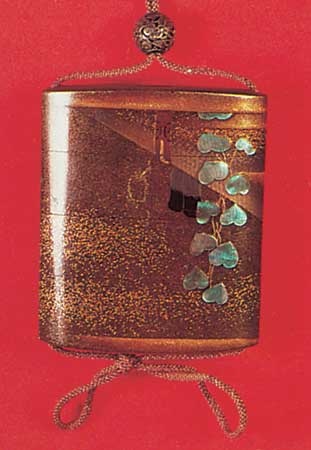hirameji
Japanese art
 (Japanese: “flat dust base”), in Japanese lacquerwork, variation of the jimaki technique. For this kind of ground decoration, small, irregularly shaped flakes of sheet gold or silver are used. The hiramefun, or “flat dust,” is made by filing solid gold and then flattening the flakes between a steel roller and a steel plate. Sieves of varying degrees of fineness are used to separate hiramefun suitable for thin, medium, thick, or dappled (usumaki, chūmaki, koimaki, or madaramaki) gold or silver finishes. The flakes are sprinkled on wet lacquer with dusting tubes; when set, they are covered with rō-iro-urushi (a black lacquer, containing no oil, created by adding an iron agent to refined, clear raw lacquer), which is polished with powdered charcoal to a fine finish. In a variation of hirameji called okibirame (“placed flat dust”), each flake is applied to the wet lacquer surface individually. It is believed that hirameji developed from a technique called heijin, practiced during the Heian period (794–1185), in which flakes filed from solid gold were sprinkled unevenly.
(Japanese: “flat dust base”), in Japanese lacquerwork, variation of the jimaki technique. For this kind of ground decoration, small, irregularly shaped flakes of sheet gold or silver are used. The hiramefun, or “flat dust,” is made by filing solid gold and then flattening the flakes between a steel roller and a steel plate. Sieves of varying degrees of fineness are used to separate hiramefun suitable for thin, medium, thick, or dappled (usumaki, chūmaki, koimaki, or madaramaki) gold or silver finishes. The flakes are sprinkled on wet lacquer with dusting tubes; when set, they are covered with rō-iro-urushi (a black lacquer, containing no oil, created by adding an iron agent to refined, clear raw lacquer), which is polished with powdered charcoal to a fine finish. In a variation of hirameji called okibirame (“placed flat dust”), each flake is applied to the wet lacquer surface individually. It is believed that hirameji developed from a technique called heijin, practiced during the Heian period (794–1185), in which flakes filed from solid gold were sprinkled unevenly.- Blossius Aemilius Dracontius
- blot drawing
- Blount, Edward
- Blount, William
- blow fly
- blowgun
- Blow, John
- blow molding
- blowpipe
- Blow, Susan Elizabeth
- Bloy, Léon
- Bludenz
- blue-and-white ware
- Blue Angels
- blueback
- Bluebeard
- bluebell
- blueberry
- bluebird
- Saint Deusdedit
- Saint Dionysius
- Saint Dionysius of Alexandria
- Saint-Dizier
- Saint-Dié
- Saint Dominic